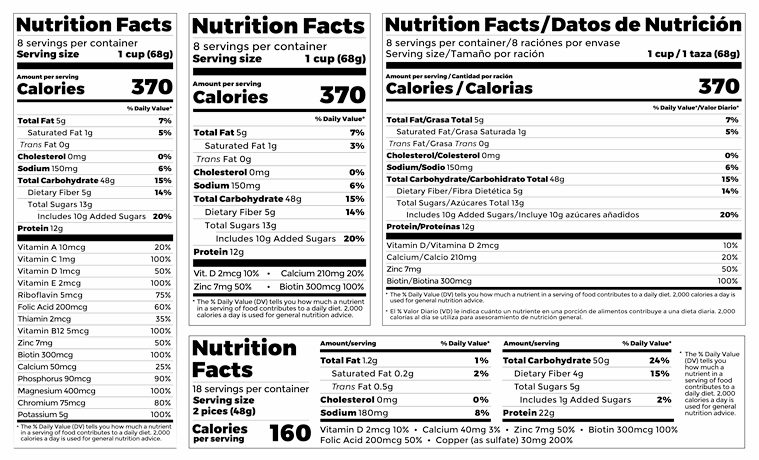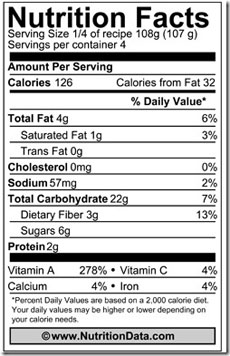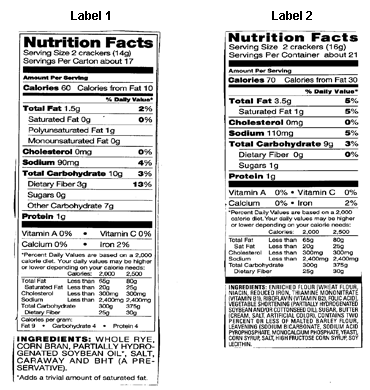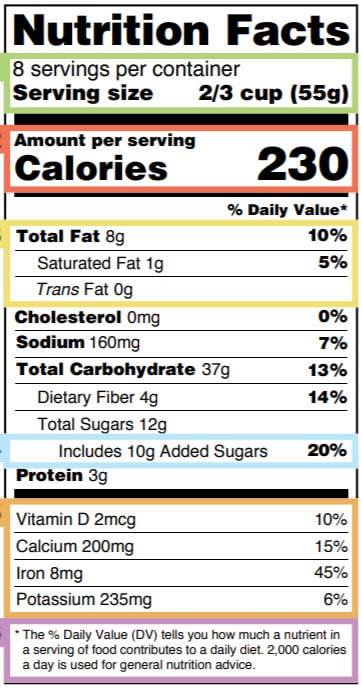44 daily value on food labels
How to read food labels | healthdirect Sugar: Sugar is a type of carbohydrate. It is better to choose healthier carbohydrates and to limit foods that are high in added sugars. Fibre: High fibre foods such as wholegrain bread and cereals improve digestion and help you to feel full. Sodium: This tells you how much salt the product contains. Eating too much salt is linked to high blood pressure and can lead to heart disease, … Percent Daily Value (%) on Nutrition Labels: Quick Guide to Reading ... Those are the numbers to remember when reading through the Percent (%) Daily Value column on the right side of the Nutrition Label. 5% is low for a nutrient 20% is high for a nutrient. Some of the nutrients you want high (above 20%): fiber, vitamins and minerals. Some of the nutrients you want low (below 5%): fat, cholesterol, sodium. That's it!
Daily Values (DVs) - National Institutes of Health Recommended intakes of nutrients vary by age and sex and are known as Recommended Dietary Allowances (RDAs) and Adequate Intakes (AIs). However, one value for each nutrient, known as the Daily Value (DV), is selected for the labels of dietary supplements and foods. A DV is often, but not always, similar to one's RDA or AI for that nutrient.

Daily value on food labels
What are daily values in nutrition? Also know, what is daily value mean in nutrition? Nutrition and healthy eating Percent Daily Value (DV) on the Nutrition Facts label is a guide to the nutrients in one serving of food. For example, if the label lists 15% for calcium, it means that one serving provides 15% of the calcium you need each day. Daily Value and Percent Daily Value: Changes on the New ... Facts Labels Daily Value vs. % Daily Value First, let’s look at how Daily Value (DV) and Percent Daily Value (%DV) work together. ... a serving of food contributes to a daily diet. 2,000 calories Understand Food Labels - UF/IFAS Extension Marion County This label is a variation of most labels, this is a dual-column label, because it informs you of the nutrition facts per serving size and per package "per unit". 3. Nutrient Section (in green): Here you find the list of the main nutrients that can affect our health in both a positive, or negative way (e.g. cholesterol, saturated fat).
Daily value on food labels. Percent Daily Value On Food Label - LabelCal These percentages are based on a daily diet of 2,000 calories, which is the recommended intake for an average adult. Percent daily values are required for most of the nutrients on your nutrition facts label, but not all of them. Here are the nutrients that must be accompanied by a percent daily value. Total Fat. Saturated Fat. Cholesterol. Sodium. A Guide to Reading Food Labels - University of Rochester 27-02-2013 · Percent Daily Value . Understanding the Percent Daily Values (% DV) on a food label can help you choose foods high in good nutrients and low in bad nutrients. The % DV is based on a 2,000-calorie diet. If you eat less than 2,000 calories a day, your daily value may be lower than what is listed on the label. If you eat more than 2,000 calories a ... Daily Value: Definition and How to Calculate It - Insider Found on the nutrition label, the daily value system tells you can help you determine if a product is high or low in particular nutrients. What does daily value mean? Daily value (DV) refers to how much of a nutrient you should consume each day based on a 2,000 calorie diet. You can find daily values for a range of nutrients on the FDA's website. How To Read Food and Beverage Labels | National Institute on … 24-02-2022 · Although frozen and canned fruits and vegetables have food labels, fresh varieties often do not. You can find nutrition information for fresh vegetables and fruits on the USDA website. Or you can call the U.S. Department of Agriculture’s Food and Nutrition Information Center at 301-504-5414. Understanding percent Daily Value (% DV)
Interactive Nutrition Facts Label Download the What's On The Nutrition Facts Label Fact Sheet. (PDF: 223 KB) Nutrition Facts 4 servings per container Serving size 1 1/2 cup (208g) Amount Per Serving 240 Calories % Daily Value* 5%... How to Calculate % of Daily Value on Food Labels | livestrong Step 1 Find the nutrient amount on the food label. Step 2 Look up the total daily recommended amount in the USDA Dietary Guidelines. Step 3 Divide the nutrient amount by the total daily recommended value. Step 4 Multiply by 100. Things You'll Need United States Department of Agriculture (USDA) Dietary Guidelines Food label Calculator Tip FDA Nutrition Label Update: How to Read the New Food Label | U.S. News ... The Daily Values (DV) for nutrients on the Nutrition Facts label have also been updated to illustrate the latest research. For example, the DV for fiber, calcium and magnesium have increased, while... Percent daily value - Canada.ca dividing the amount of a nutrient in a serving size by its daily value, then multiplying that number by 100 For example, a food product has 3 mg of iron. The daily value for iron is 14 mg. This means that the % DV for iron would be 21%. If you would like to do your own calculation, use the equation below to help you. (3 mg ÷ 14 mg) × 100 = 21% DV
Daily Value on the New Nutrition and Supplement Facts Labels 25-02-2022 · Daily Value vs. % Daily Value. First, let’s look at how Daily Value (DV) and Percent Daily Value (%DV) work together. DVs are the recommended amounts of nutrients to consume or not to exceed ... How you can Calculate % of Daily Value on Food Labels How to Calculate % of Daily Value on Food Labels. Step 1. Find the nutrient amount on the food label. Step 2. Look up the total daily recommended amount in the USDA Dietary Guidelines. Step 3. Divide the nutrient amount by the total daily recommended value. Step 4. Food Labels | CDC In general, eat more foods that are higher in vitamins, minerals (such as calcium and iron), and fiber. Eat fewer foods that are higher in added sugars, saturated fat, and sodium (salt), and avoid trans fat. Keep in mind that the % Daily Value of each nutrient, such as total fat of 10% in the example below, is based on eating 2,000 calories a day. Solved Daily Values on food labels are based on a | Chegg.com Biology questions and answers. Daily Values on food labels are based on a 200o-kcalorie/day diet. A man wants to calculate a personal Daily Value based on his 1800-kralorie diet. Calculate a daily goal (in grams) for carbohydrates using Table 2-8. TABLE 2-8 Daily Values for Food Labels Food labels must present the "% Daily Value for those ...
The Basics of the Nutrition Facts Label 04-03-2022 · Good source of: Provides at least 10 to 19% of the Daily Value of a particular vitamin or nutrient per serving. Excellent source of: Provides at least 20% or more of the Daily Value of a particular vitamin or nutrient per serving. Calorie free: Less than five calories per serving. Fat free/sugar free: Less than ½ gram of fat or sugar per serving.
eCFR :: 21 CFR Part 101 -- Food Labeling In addition to providing a column within the Nutrition Facts label that lists the quantitative amounts and percent Daily Values per serving, for a product that is packaged and sold individually that contains more than 150 percent and less than 200 percent of the applicable reference amount, the Nutrition Facts label may voluntarily provide, to ...
A Guide to Reading Food Labels - University of Rochester Feb 27, 2013 · Percent Daily Value . Understanding the Percent Daily Values (% DV) on a food label can help you choose foods high in good nutrients and low in bad nutrients. The % DV is based on a 2,000-calorie diet. If you eat less than 2,000 calories a day, your daily value may be lower than what is listed on the label. If you eat more than 2,000 calories a ...
Daily Value on the New Nutrition and Supplement Facts Labels (3) The Daily Value decrease for vitamin E applies for foods/supplements containing the natural form of vitamin E, but not for the synthetic form. For foods/supplements containing only the...
Daily Values (DVs) - National Institutes of Health Recommended intakes of nutrients vary by age and sex and are known as Recommended Dietary Allowances (RDAs) and Adequate Intakes (AIs). However, one value for each nutrient, known as the Daily Value (DV), is selected for the labels of dietary supplements and foods. A DV is often, but not always, similar to one's RDA or AI for that nutrient.
Understanding Ingredients on Food Labels | American Heart … Food labels are an important source of information about calories and the nutritional value of the foods you eat, a crucial tool in building a heart-healthy diet. The Nutrition Facts information is always displayed in the same orderly fashion and helps you understand how much of certain nutrients that you need to limit are contained in the product per serving.
How To Read Food Labels - Fit Me Solution The Daily Value for iron is 18 milligrams, so 1 milligram of iron is enough to take notice of: it is more than 5 percent. But because the current Daily Value for calcium on food labels is 1000 milligrams (and the proposed is 1300), 1 milligram of calcium is a negligible amount.
How To Calculate Percent Daily Value for Food Portions It's time to do some math! The Percent Daily Value is calculated by dividing the amount in a serving by the total recommended daily amount. Multiply that answer by 100, and you've got your %DV! For example: 3g in a serving 15g recommended per day 3/15 = 0.2 0.2 x 100 = 20%
How to Understand and Use the Nutrition Facts Label | FDA The % Daily Value (%DV) is the percentage of the Daily Value for each nutrient in a serving of the food. The Daily Values are reference amounts (expressed in grams, milligrams, or micrograms) of...

Food label ingredients, good to consume and not good to consume. Pg 3 of 7. | Flavor enhancers ...
What Does "% Daily Value" Mean on a Food or Supplement Label? The U.S. Food and Drug Administration (FDA) recommends 400 IU, so that's what the Daily Value is set at. The Institute of Medicine recommends getting between 600 and 800 IU per day (as does Health Canada ). Dr. Oz recommends 1,000 IU. Dr. Andrew Weil recommends 2,000 IU. The Linus Pauling Institute recommends 2,000 IU.
Percent Daily Value: What does it mean? - Drugs.com Last updated on Apr 25, 2022. Percent Daily Value (DV) on the Nutrition Facts label is a guide to the nutrients in one serving of food. For example, if the label lists 15% for calcium, it means that one serving provides 15% of the calcium you need each day. DV s are based on a 2,000-calorie diet for healthy adults.
Food Labels (for Teens) - Nemours KidsHealth Percent daily value is most useful for seeing if a food is high or low in nutrients: A food with 5% or less of a nutrient is low in that nutrient. A food with 10%–19% of a nutrient is a good source of that nutrient. A food with 20% or more of a nutrient is high in that nutrient. The information on food labels is based on an average adult diet ...
Explained: How food labels will change in India from today 01-07-2022 · Explained: How food labels will change in India from today The new directives by FSSAI mandate e-commerce food companies like Swiggy and Zomato to display the calorific value and information related to nutrition and allergen of a food item on packages
Understanding food labels - Canada.ca Find information on food labels and how to understand them. Learn about nutrition facts tables, serving size, ... Learn about nutrition facts tables, serving size, list of ingredients, % daily value and nutrition claims. Skip to main content; Skip to "About government" Language selection. Français fr / Gouvernement du Canada. Search.
How To Read Food and Beverage Labels | National Institute on ... Understanding percent Daily Value (% DV) The percent Daily Value (% DV) tells how much a nutrient in a serving of the food or beverage contributes to a total daily 2,000-calorie diet. Although the average person needs 2,000 calories a day to maintain their weight, individuals may need more or fewer depending on their lifestyle. If you are ...
How Well Do Consumers Understand Percentage Daily Value on Food Labels ... How Well Do Consumers Understand Percentage Daily Value on Food Labels? Lisa Levy, MC, MPH , Ruth E. Patterson, PhD, RD , Alan R. Kristal, DrPH , and Sue S. Li, PhD American Journal of Health Promotion 2000 14 : 3 , 157-160
The Vegetarian Resource Group Blog - VRG Daily Values are established by the FDA. The Daily Value for a nutrient is a single value, often similar to the Recommended Dietary Allowance (RDA), that is selected to be used for the labels of foods and supplements. Daily values are amounts of nutrients that people are recommended to consume or not to exceed each day.







Post a Comment for "44 daily value on food labels"